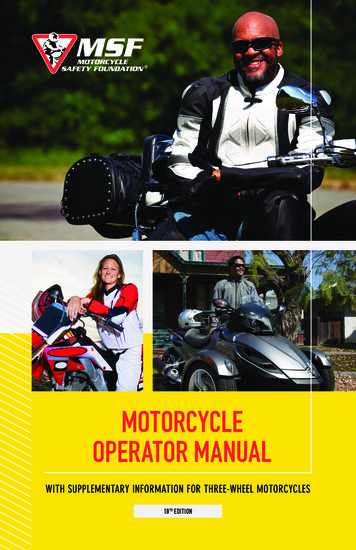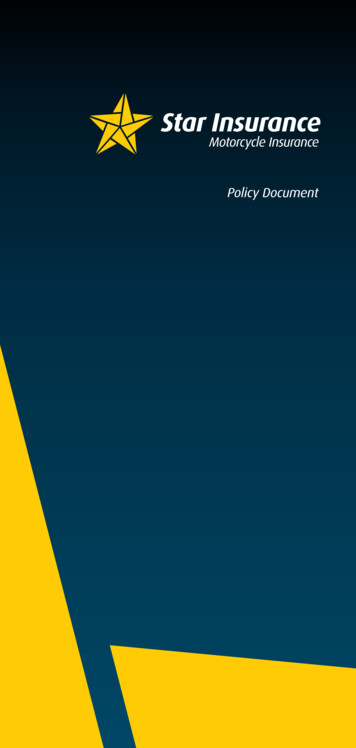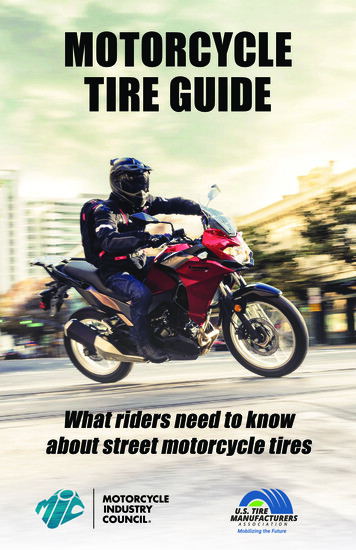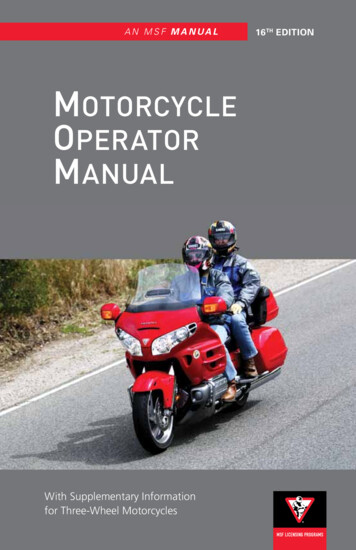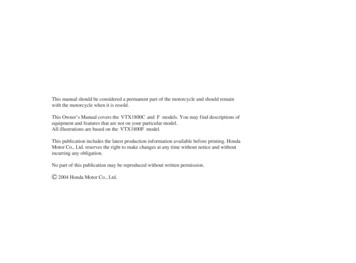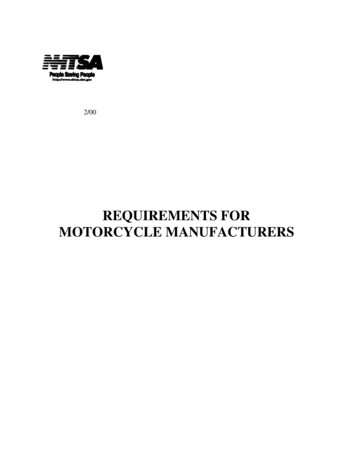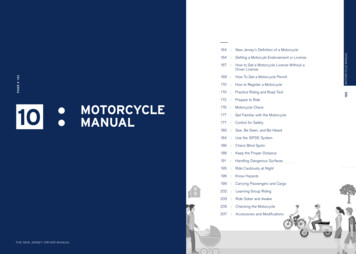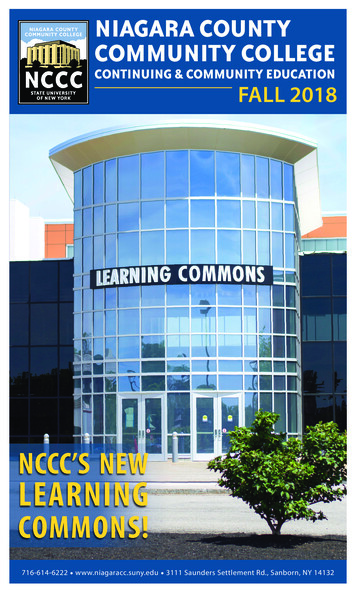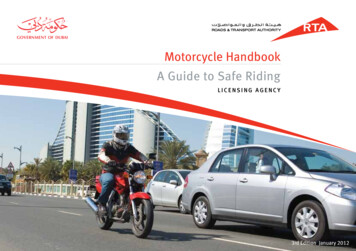
Transcription
Motorcycle HandbookA Guide to Safe RidingLICENSING AGENCY3rd Edition January 2012
Motorcycle Handbook A Guide to Safe ridingTable of ContentsThis Handbook5Part 1 : Why Read This Handbook?Motorcycle LicencePart 2 : Be Aware7811Alcohol11Other Drugs or Medical ConditionsTirednessRelying on Other Road Users for Your SafetyPart 3 : What to WearHelmetEye and Face Protection121213151513Clothing17Part 4 : What to Ride19Which Bike is Right For You?Be Careful With a Different Bike19201
Motorcycle Handbook A Guide to Safe ridingPart 5 : Starting OutTable of Contents23Part 9: Night RidingA Simple Guide to the Parts of a Bike24Setting Up for Yourself and Your Bike25Take CareSafety Checks to Make Before Each Ride26Part 10: Pillion Passenger and Loads31Carrying a Pillion PassengerPart 6: Look Ahead and Be SeenSeeing and Being Seen at NightLooking Ahead31Good Positioning32Place Yourself Where You Are as Safe as Possible32MaintenanceHeadlight32Part 12: EmergenciesIndicators and Brake LightsCarrying a LoadPart 11: Look After Your Bike33Emergency BrakingSound Your Horn34SkiddingBe Seen To Be Safe34Swerving37Bumps and HolesKeeping a Safe Space37Eye SightScanning41Animal WarningRemember to Plan42Blow-outPart 7 : Stay Away from DangerPart 8 : Grip On the Road45Mechanical ProblemsSlippery Roads45Pulling Off the RoadBumpy Roads and Potholes46Dealing With a 03
Motorcycle Handbook A Guide to Safe ridingThis HandbookThe aim of this handbook is to help you to become a safe motorcycle rider and is based on an approach calleddefensive riding. The handbook is divided into 12 parts. You should read them all and try the Check YourUnderstanding questions at the end of each part. These questions let you: review the information check your understanding.Road safety is important to all road users and especially to motorcyclists. In a crash you have lessprotection than a driver.Please keep in mind that getting your licence, even after all the training, does not make you anexperienced and safe rider. It takes years of practice to learn all the skills and correct ridingtechniques. Remember, as an inexperienced rider, you are more likely to be involved in a crashthan an experienced rider.In the meantime, this handbook can be a great help. When it says ‘bike’ this means anymotorcycle or motor scooter. If it is talking about a specific kind of bike, it will use morespecific terms. Otherwise, it will simply say ‘bike’. When it says ‘rider’ it means motorcycle ormotor scooter rider.Bike riders must obey the same rules as drivers. The Light Motor Vehicle Handbook hasgeneral rule information for all road users and should be read with this handbook.45
Motorcycle Handbook A Guide to Safe ridingPart 2: Be AwareThere are many hazards on the road for all riders, so it makes sense to try to be ready for anything.Build up your skills gradually by riding in daylight before riding at night. You are almost twice as likely tohave a crash in your first months of riding. In the meantime, slow down and give yourself more space onthe road by thinking ahead. Do not be overconfident, impatient or in the wrong mood to ride, such aswhen you are angry or upset. Learn to identify danger and how to deal with it.AlcoholYou must not ride or drive under the influence of alcohol because it: reduces your ability to judge risks including distance and speed affects your sense of balance makes you take risks makes it difficult to concentrate and control your bike at the same time.If you ride under the influence of alcohol you might not see hazards, or react to them in timeto avoid a crash.1011
Motorcycle Handbook A Guide to Safe ridingPart 2: Be AwareOther Drugs or Medical ConditionsRelying on Other Road Users for Your SafetyAny kind of drug can affect your ability to ride. Check with a pharmacist or doctor before you ride. Mixing drugs with alcohol orother drugs can be especially dangerous. If you are not sure about a drug you have taken, do not ride.You are responsible for your own safety. Do not expect other road users to look after you. Evenif you are wearing bright clothing and making eye contact, do not assume that they have seenyou.If you have a medical condition which might affect your ability to ride, such as diabetes or epilepsy, you must check with the RTAwhether you are eligible for a learner licence or licence. If you develop such a condition once you have a learner licence or licence,you must advise the RTA.TirednessRiding a motorcycle is more tiring than driving a car. Tiredness and dehydration in hot weather makes it difficult for you to makedecisions, especially quick decisions. Being tired affects concentration, balance and vision. If you are tired, do not ride.Make your riding less tiring by: wearing protective clothing because it helps prevent dehydration avoiding alcohol and drugs making frequent stops if you are riding for a long time resting before you start not riding during those times when you would normally be asleep avoiding busy traffic.Check Your Understanding(Answers to these review questions are upside down at the bottom of this page)Q1. You are planning a long trip, but you have a cold. You want to take medication. You should:Atake some medicine to make you feel betterBask your doctor or pharmacist whether the cold medicine will make you sleepy or drowsyCtry to get there as quickly as possible, so that you can rest when you arrive.Q2. Here are three types of drugs which people sometimes take: alcohol, medicines prescribed by a doctor andmedicines sold by a pharmacist. Which drug may affect your riding?A Only alcohol.B Only medicines given to you by your doctor.CAll three types.Answers: Q1B, Q2C1213
Motorcycle Handbook A Guide to Safe ridingPart 6: Look Ahead and Be SeenAs a motorcyclist you need to be seen by other drivers. You need to see clearly around you to think aheadand be ready to respond before things happen. Remember that you are sharing the road with others, so ridecooperatively in traffic.Looking AheadBeing ready to respond to things before they happen. It is not as hard as it sounds. Experienced ridersare very good at it, which is one reason why they are usually safer.Help yourself by doing the following: Always turn your head and looking ahead to where you want to go. Position yourself on the road so you can see around corners. Lean with your bike while you turn, keeping your head up and line of sight level withthe road. When pulling out from the kerb, position your bike so you can see the traffic in bothdirections. If you are making a U-turn, have a clear view of traffic in both directions. At intersections do not count on other vehicles giving way to you. Watch the road ahead by looking through or over the top of other vehicles.3031
Motorcycle Handbook A Guide to Safe ridingPart 6: Look Ahead and Be SeenGood PositioningIndicators and BrakeLightsPlace yourself on the road where you can see and be seen. Ride in the left-handwheel track of the road, where you can be seen in both the rear vision mirror andthe external mirror of the car in front of you. You can also see vehicles coming theother way and be seen by them.BlindSpotBlindSpotIndicators and brake lights tell otherdrivers what you are about to do. Place yourself where you can see and be seen by other drivers. Most crashes between a bike and a vehicle happen at intersections, soposition yourself where you can be seen and have as much room as possibleto avoid a crash.Before you turn or change lanes, youmust use your indicators. Send clearmessages to the other traffic. Turn yourindicator off afterwards, because if youleave it on after you have made the turnyou are giving the wrong message, whichcould be dangerous. Blind spots beside other vehicles are dangerous because drivers cannotsee you.Start braking early so drivers know thatyou are about to slow down.Place Yourself Where You Are as Safe as PossibleHeadlightRiding with your headlight on during the day will help you to be seen by otherroad users. If you have your headlight on during the day, always use low beam.32Giving the wrong signals could lead to danger.33
Motorcycle Handbook A Guide to Safe ridingPart 6: Look Ahead and Be SeenSound Your HornCheck Your UnderstandingSound your horn as a warning in case of danger to let other road users,who have not seen you, know that you are there.(Answers to these review questions are upside down at the bottom of this page)Never rely on the horn though, because it may not be heard.Always be ready to avoid a crash.Q1. Farid is about to pull out from the kerb to join the traffic flow. He should:A accelerate as quickly as possible, so that he is going faster than the traffic and itcannot catch himBput on his indicator, because that gives him right of wayCmake sure he positions the bike so he can see the traffic in both directions before pulling out.Q2. The three best ways to make yourself be seen are to:Be Seen To Be SafeAride with your headlight on, ride where you can be seen and wear bright clothingBsound your horn, keep to the left of the road and flash your headlightWearing brightly coloured or reflective helmets and clothing helps otherdrivers see you. Yellow, orange and red are colours which stand outagainst most backgrounds. Reflective tape on your clothing or your bikeworks well at night, and a reflective vest is more noticeable to driversbehind you than a tail light.Call of the above.There may still be drivers who simply do not see you, or who do not obeythe road rules. You need to be ready to avoid a crash at all times.Q3. At an intersection you should:Achange lanes to get past other vehiclesBchoose a lane position which will enable you to be seen by other driversCsound your horn and then speed through as quickly as possible.Answers: Q1C, Q2A, Q3B3435
Motorcycle Handbook A Guide to Safe ridingPart 7: Stay Away from DangerStay as far away as possible from the things that can hurt you on the road.Keeping a Safe SpaceAny mistake, yours or someone else’s, can be very serious for you as a rider. Keeping a safe space isthe best protection you can have. The more space you have around you, the more time you have to seetrouble and work out a way to avoid it. Of course, that only works if you keep your eyes open and yourmind alert.The 3 Second GapMeasuring a safe following distance is simple. When the vehicle ahead of you passes a tree orsomething similar, use that as a reference point and start counting – “one thousand and one, onethousand and two, one thousand and three”. If you get to the tree before you finish counting, youare too close. After a while you will get good at judging this gap.3 seconds3637
Motorcycle Handbook A Guide to Safe ridingPart 7: Stay Away From DangerIn FrontTo the SideAs an unprotected rider, you should try to keep a 3 second gap between you and the vehicle in front, so you:When riding in traffic you can move fromone side of your lane to the other, awayfrom other vehicles, and make a biggersafety zone. Experienced riders movelane position depending on traffic – butthey always check their mirrors and do aheadcheck before they do! have more time to stop in an emergency are able to see better over and around the vehicle in front of you can see traffic signals, road signs and hazards well ahead be able to avoid potholes and other road surface hazards have more time to plan your response.If you are too close, you may pay too much attention to the vehicle in front and not of what is ahead.There are times when you will want to be even further than 3 seconds away. They include: poor riding conditions when it is harder to be seen (for example riding at night) on slippery, sandy or uneven road surfaces on a high speed roads being behind a big vehicle which is hard to see around.A headcheck means looking back behindyou to make sure nothing is about to passyou. Using mirrors is good, but sometimesyou will need to look as well.Consider changing position when: You are being overtaken or passed byanother vehicle. You are approaching an intersection. Ifyou see a car that could turn into yourpath, assume that it will and be readyfor it. You are passing parked cars orvehicles waiting to turn left. Keep tothe left part of the lane, away fromthe possibility of doors opening orpedestrians stepping out from betweencars.Do not ride too close behind another vehicle. They might stop suddenly and you might not be able to stop in time to avoid a crash.3839
Motorcycle Handbook A Guide to Safe ridingPart 7: Stay Away From Danger Scanning A driver is pulling out from the kerb.Some people do not turn their heads todo a headcheck to see if there is trafficcoming up, and bikes can be hard to see.The car might also be doing a U-turnacross your path, instead of just goingstraight ahead.In traffic you need a full lane to yourselfto be able to move safely if a problemcomes up. Avoid being trapped in asmall space with cars sharing your lane,by positioning yourself away from theextreme edges of the lane.There is another vehicle beside you in thenext lane. They may move over on you atany time. Move forward or drop back untilyou are in a free space.Vehicles are merging. At places such as freeway entrance ramps, make room for entering traffic by changing speed or changinglanes.BehindIf someone is too close behind you, slow down and move back yourself to increase the space between you and the car in front.Then let the car behind overtake you where you can see it.40Scanning means gathering information aboutthe road scene around you by looking ahead,from side to side and in your rear view mirrorsto identify dangers. You do not have to lookdirectly at everything. Sort the informationin order of its importance to you. It takespractice, but it is worth learning.Use the height advantage you have on amotorcycle and look over cars in front of you.Use that advantage to see what is coming upahead.Combine mirrors and headchecks to give youa picture of what is happening behind you. Dothis often and quickly, because what is behindyou is important too. Remember, headchecksshould only take a second so you can look backto the front quickly.Always do a headcheck of the lane next toyou and behind you, in your own lane, whenyou change lanes or leave the curb. Anothervehicle may be headed for your space, and itmay not be visible in your mirrors.Make sure you do a headcheck beforechanging lanes or a situation like thismay occur41
Motorcycle Handbook A Guide to Safe ridingPart 7: Stay Away From DangerRemember to PlanQ3. When you are being followed too closely you should:Scanning ahead lets you decide what to do about dangers before you get to them, so you can avoid emergency stops or suddenmoves. Experienced riders know that other road users make mistakes and try to plan how they will act before it happens.Pick the safest and easiest way to get to where you want to go. If roads are busy, consider changing your travel plan to a time whenthere will be less traffic.Check Your Understanding(Answers to these review questions are upside down at the bottom of the next page)Q1. The gap between your motorcycle and the vehicle ahead, in good conditions, should be at least:A2 secondsB3 secondsC4 seconds.Q2. Jamal is riding along a freeway in the right lane. Cars are moving on to the freeway from the entrance ramp. He should:Aaccelerate to get ahead of themBcontinue to travel at the same pace and position as it is their responsibility to merge into the traffic safelyCadjust his speed to increase the distance between his bike and the merging traffic.Atravel faster to increase the distance between you and the vehicleBbrake several times to let the driver know that you think he is driving dangerouslyC slow down and increase the space in front of your motorcycle so you have more timeto react, if you need to.Q4. Scanning involves:Astudying the movements of the car ahead of youBlooking at the road just ahead of youCmoving your eyes from side to side to look at the whole road scene.Q5. Before changing lanes always do a final:Asound of your hornBheadcheckCflash of your brake lights.Q6. To prevent other drivers sharing your lane you should:Aride to the left of your laneBride to the right of your laneCnot ride at the extreme edges of your lane.Answers: Q1B, Q2C, Q3C, Q4C,Q5B,Q6C4243
Motorcycle Handbook A Guide to Safe ridingPart 8: Grip On the RoadThere are only two patches of rubber connecting you to the road surface and they are smaller than the palmof your hand. There are several things that will make it harder to keep a grip when riding.Slippery RoadsMany things can make the road surface slippery. Here are some common slippery situations youmay find: Unmade roads or patches of sand that have collected on sealed roads. Wet roads. Painted lane and other markings, as well as steel and other naturally smooth surfacesincluding covers and bridge expansion joints. Grease and oil deposited in the middle of lanes, and diesel spills.Try to avoid slippery patches. If you cannot, reduce your speed before you get to them, ride asupright as you can once you reach them and try to avoid changing gear, turning or using thethrottle or the brakes. If you need to brake, use both brakes evenly.4445
Motorcycle Handbook A Guide to Safe ridingPart 8: Grip On the RoadBumpy Roads and PotholesCheck Your UnderstandingOn rough roads, slow down. That does three things:(Answers to these review questions are upside down at the bottom of this page) gives you time to avoid the worst bumps or holes reduces road shocksQ1. The best way to handle a slippery surface is to: gives your bike’s suspension time to work.Remember that bumps can affect your steering as well as the suspension. To give yourself as much control as possible, raiseyourself a little on the footpegs so you can absorb road shocks with your knees and elbows.Atravel on the right side of the roadBuse the rear brake if you are in troubleCreduce your speed.Q2. To ride safely along a bumpy road you should:Aslow down quickly after the first series of bumpsBrise slightly on the footpegs to absorb the road shocksCsit on the seat and try to steer your way through the bumps.Q3. Grease and oil from cars tends to build up:Aalong the sides of the roadBin the centre of the laneCin the right hand part of the lane.Answers: Q1C, Q2B, Q3B4647
Motorcycle Handbook A Guide to Safe ridingPart 9: Night RidingSeeing and Being Seen at NightIt is harder to see and to be seen at night. Your headlight will not show you the road as clearly as daylightwill. Other road users may also have trouble seeing your headlight or tail light because of other traffic.Your headlight and tail light must be on between sunset and sunrise, when street lights are switched on,and in weather conditions with reduced visibility.Do not wear a dark tinted or scratched visor or tinted glasses, especially at night. You need to be ableto see as clearly as possible.If an oncoming vehicle has not dipped its high beam, or if its light is too bright for you, slow downand look at the side of the road ahead of you instead of at the vehicle, until it has gone past. Oftenthere is a line there that you can use as a guide. That way you can keep track of where the road isgoing, and your vision will not be affected.The tail lights of the traffic you are following can show you which way the road goes. If taillights ahead of you bounce up and down, expect a rough road surface ahead.4849
Motorcycle Handbook A Guide to Safe ridingPart 9: Night RidingTake CareRide more slowly at night to give yourself more time to react to problems. Ride further away from other traffic; it is difficult to judgedistance and speed at night. Always remember, do not ride when you are tired!Check Your Understanding(Answers to these review questions are upside down at the bottom of this page)Q1. Three things you can do to ride more safely at night are:Astay closer to other vehicles, always use the high beam and wear dark, warm clothingBreduce your speed, increase the distance between your motorcycle and the car ahead, wear a reflective vestCchange the type of tyres on your motorcycle, stay closer to other vehicles, keep up with the flow of traffic.Q2. Salim notices the lights of the oncoming vehicles seem to bounce up and down. He should:Ause his high beam to get a clearer look at the road aheadBreduce his speed and expect a change in road conditionsCmove to the centre of the road.Answers: Q1B, Q2B5051
Motorcycle Handbook A Guide to Safe ridingPart 10: Pillion Passengers and LoadsThe way your motorcycle behaves will change when you carry a passenger or a load. It will: take longer to stop accelerate slower have less cornering clearance in corners.Carrying a Pillion PassengerPassengers who are not used to being on a bike can get scared and affect the safety of the motorcycle.Ask them to relax, hold onto the bike’s ‘grab rail’ or your waist and lean with the bike when it leans.Pillions should wear the same kind of brightly coloured protective clothing and helmet as riders.Getting ReadyIf it is possible, you should adjust the preload of the bike’s suspension when you are carryingextra weight. You may also have to add air to the tyres. Check your owner’s manual forinstructions.Adjust your mirrors with you and the passenger both sitting on the bike before you startriding.On the RideIt is important to ride slower and very smoothly when carrying a passenger. Do not talkbecause this will reduce your concentration and take your attention off the road.5253
Motorcycle Handbook A Guide to Safe ridingPart 10: Pillion Passengers and LoadsCarrying a LoadBikes are not designed to carry large loads, but if you distributethe weight evenly there is no reason why small to mediumloads should be a problem. The owner’s manual should giveyou the total amount of weight the bike is designed to carry,including rider and passenger.There are many different kinds of luggage available for bikesand you may want to use more than one of these to balance theweight when you load your bike. Keep the load: Low – if it is high it may unbalance the bike. Do not carryanything heavy on your back. Forward – by placing it above or in front of the rear axle.Anything behind the rear axle can have a serious effect onhandling. Balanced – even weight on either side of bike. Secure – by putting it in a special motorcycle bag orstrapping it carefully to the bike. Be very careful if you useelastic straps with metal hooks – these are a major cause ofeye loss.Check Your Understanding(Answers to these review questions are upside down at the bottom of this page)Q1. Paul is taking his brother to his night class. He should:Agive him advice on how to ride as a pillion passenger as they are ridingBnot speak at all because he cannot hear him clearly when ridingCgive his brother instructions about being a pillion passenger before they start.Q2. When you are carrying a passenger the motorcycle will:Arespond more slowly, taking longer to speed up and slow downBrespond more quickly, because the weight improves the handling ability of the motorcycleCnot change the way it handles, as long as the weight is spread evenly.Finally, check the load frequently to make sure that it is stillsecure.Answers: Q1C, Q2A5455
Motorcycle Handbook A GuidE to SAfE RidinG 4 5 This Handbook the aim of this handbook is to help you to become a safe motorcycle rider and is based on an approach called defensive riding. the handbook is divided into 12 parts. You should read them all and try the Check Your understanding qu
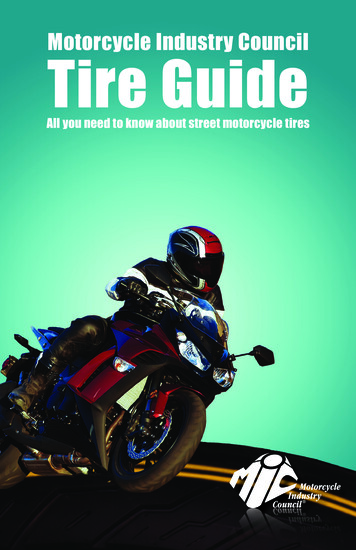
![Motorcycle Mechanic [MM] - CTEVT](/img/5/motorcycle-20-20mechanic-2010.jpg)
